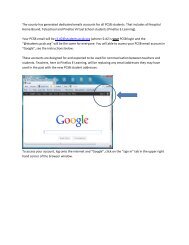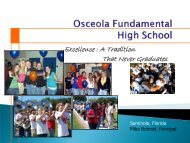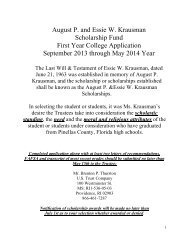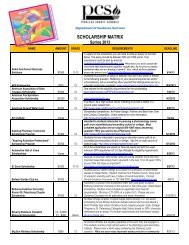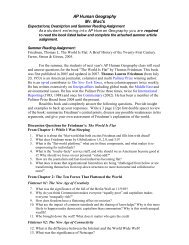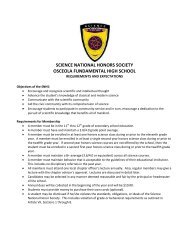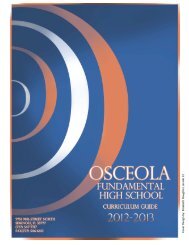Florida US History End-of-Course Assessment Test Item Specifications
Florida US History End-of-Course Assessment Test Item Specifications
Florida US History End-of-Course Assessment Test Item Specifications
- No tags were found...
Create successful ePaper yourself
Turn your PDF publications into a flip-book with our unique Google optimized e-Paper software.
The following table is provided for ease <strong>of</strong> reference; however, caution must be used in<br />
referring to this table <strong>of</strong> descriptors for each cognitive complexity level. The ultimate<br />
determination <strong>of</strong> an item’s cognitive complexity should be made considering the intent <strong>of</strong> the<br />
overall cognitive demand placed on a student.<br />
Examples <strong>of</strong> U.S. <strong>History</strong> Activities<br />
across Cognitive Complexity Levels<br />
Low Complexity Moderate Complexity High Complexity<br />
• Identify or recall common<br />
historical events, actions,<br />
personalities, or concepts.<br />
• Use a chart, table, diagram,<br />
graph, or image to recall or<br />
recognize information.<br />
• Identify characteristics <strong>of</strong> a<br />
particular group, place, or<br />
event.<br />
• Apply or infer cause and<br />
effect relationships.<br />
• Identify outcomes <strong>of</strong><br />
particular cause and effect<br />
relationships.<br />
• Identify the significance <strong>of</strong><br />
historical events, actions,<br />
personalities, or concepts.<br />
• Categorize historical<br />
people, places, events, or<br />
concepts.<br />
• Determine the relationship<br />
between historical events,<br />
actions, personalities, or<br />
concepts.<br />
• Explain historical<br />
problems, patterns, or<br />
issues.<br />
• Identify similarities and<br />
differences.<br />
• Solve or predict the<br />
outcome <strong>of</strong> a problem.<br />
• Generalize or draw<br />
conclusions when<br />
presented with historical<br />
information.<br />
• Provide justification for<br />
events, actions, or issues in<br />
history.<br />
• Predict a long-term result,<br />
outcome, or change within<br />
society.<br />
• Analyze how changes have<br />
influenced people or<br />
institutions.<br />
• Recognize and explain<br />
historical misconceptions.<br />
• Analyze similarities and<br />
differences.<br />
The table below shows the target range for the percentage <strong>of</strong> points by cognitive complexity<br />
level on each U.S. <strong>History</strong> EOC <strong>Assessment</strong>.<br />
Percentage <strong>of</strong> Points by Cognitive Complexity Level<br />
for U.S. <strong>History</strong> EOC<br />
Grade Low Moderate High<br />
U.S. <strong>History</strong> EOC 20%–30% 45%–65% 15%–25%<br />
12 | U.S. <strong>History</strong> <strong>End</strong>-<strong>of</strong>-<strong>Course</strong> <strong>Assessment</strong> <strong>Test</strong> <strong>Item</strong> <strong>Specifications</strong> <strong>Florida</strong> Department <strong>of</strong> Education



